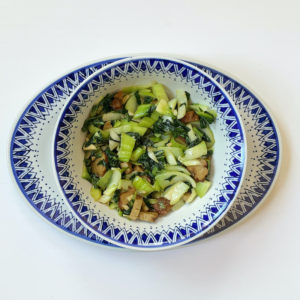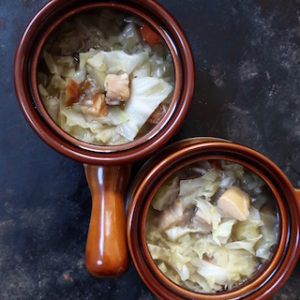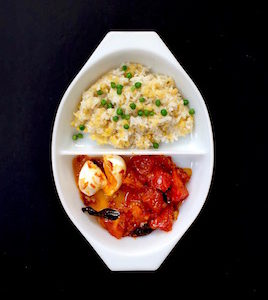Seitan at home
Prior to encountering seitan in How To Cook Everything Vegetarian, on page 668–when Bittman says everything, he means it–I’d met it once before, in a Chinese restaurant on University Avenue in Berkeley, California. (The name of this place eludes me. Nor could I find it on the net.) Technically it was more than once, as I lunched there often, always ordering the same dish: Spicy Stir-Fried Chicken. It was delicious, and I devoured it with gusto many times before realizing it wasn’t chicken at all. In fact, there was nary a bird about the place, a fact made plain on the signage and menus, all of which included the word “vegetarian.”

Taken near Berkeley’s upscale Fourth Street Shopping District many years ago, in the Before Time. This is near our house, but we rarely go there. I forget why we were there that day. It was close to Christmas, and cold.
The “chicken” was made from seitan, as was every other protein-based dish in the place. I had no idea what seitan was and didn’t care. Anything that good was worth eating, and I lunched there regularly until a new job on campus meant moving to a building far from the restaurant.
Proust had his madeleine. I have seitan. So…instagrammable.

Seitan is incredibly easy to make at home. It begins life as something called vital wheat gluten. I ordered mine from Kalyustans, whose package helpfully explains it comes from the “protein in the endosperm of the wheat berry.” Vital wheat gluten–I’m not sure when it becomes seitan–is then ground into a granular beige substance.

Add water, and within seconds you have a bouncy handful of doughy stuff that, after a twenty-minute rest, is poached in either water or broth. Violà, seitan.

Bittman offers two broth recipes in his book. I used neither, opting to concoct one myself.

Dried lobster mushrooms aren’t what you’d call a larder ingredient. I get that. These were bought months ago, for a special occasion that never transpired. The kombu has been in there even longer.

All to say, don’t fret. Use what you’ve got in your fridge, within bounds. Be practical. Obviously you don’t want to make broth from wilted, slimy, or otherwise ailing vegetables. Nor should you use anything sulfurous, like cabbage or turnip, as they tend to take over, and there’s enough of that happening elsewhere.

Symbolism? Me? Never.
Carrots, onions, garlic, leeks, scallions, and fresh mushrooms all make nice broths. Should you have corn cobs or pea pods (I write this in early September, the tail end of gardening season), they make delicious additions as well.

If you have a favorite broth recipe, use that. Avoid broth cubes, as even the finest ones may be overly salty for this application.

It tastes better than it looks. Believe me.
If you have none of these things, water is fine, too, but even that is running short these days. The world is a mess. But you knew what.

I could lie and tell you I know why there are so very many dried mushroom pictures. But….I don’t know. The past week was a corker.
My adventures with seitan have extended no further than Asian cuisine, where they’ve met with wild success (read: even John liked them). To this end, the next post will share stir-fried Seitan with Spicy Chinese Mustard Pickle.

A final note: it must said that seitan is made from gluten, a much villianized and wrongly maligned ingredient. But gluten is dangerous, even deadly, for Celiac sufferers. If you or somebody you cook for has celiac, or is wheat intolerant, seitan is not for you.

Seitan
Please read notes before beginning recipe. Instructions for kneading seitan by machine are given in the notes.
Seitan recipe from Mark Bittman’s How To Cook Everything Vegetarian; broth recipe is mine
Prep time: about 25 minutes for the kneading and resting, then another hour for poaching in broth
yield: 1-1.5 pounds /454-680 grams seitan
For the Seitan:
1 cup/8 ounces/225 grams Vital Gluten Flour
3/4 cup/6 ounces/170 ml water
For the poaching broth: Please see notes, below, for a discussion of broth types and ingredients
6 cups/scant 1.5 liters water
1/3 cup/5 tablespoons/75 ml soy sauce
1 tablespoon dried lobster mushrooms or dried mushrooms of your choice
6 dried shiitake mushrooms
1 large yellow onion, trimmed, outer layers removed, quartered
6 garlic cloves, crushed and peeled
handful parsley stems
pea pods
1 piece of kombu/kelp
6-10 black peppercorns
1 star anise
2 tablespoons rice wine or sherry
1 black cardamom pod, cracked with the flat side of a chef’s knife (or 2-3 green, lightly cracked)
1 bay leaf
thick slice fresh ginger, unpeeled
pepper
You will need a large bowl and a soup pot to make seitan.
Make the seitan:
Measure 8 ounces/225 grams of seitan into a large bowl. Pour 6 ounces/170 ml of water into the bowl and mix it up with a wooden spoon or your clean hands. It should quickly cohere into a rubbery mass resembling the toy slime of your childhood. If you need to add a bit more water or flour, do so, but not too much. The dough will feel bouncy and appear rather unappetizing. Knead for about five minutes, then cover with a dishtowel and let it rest for 20 minutes. Do not let it rest more than 30 minutes.
While the dough rests, prepare the broth. Pour 6 cups/1.5 liters of water into a large soup pot and heat to low simmer.
Add the ingredients listed and allow to simmer over low heat.
When 20 minutes has elapsed, cut the dough into two portions. Bittman advises rolling the seitan into log shapes before adding it to the broth, but I found my seitan resistant to shaping. I had two rubbery beige things that stubbornly refused to do anything I asked of them, so I just slipped them into the pot.
Turn the heat up, bring the broth to a boil, then back down to a simmer. Cover the pot. Turn the seitan once or twice with tongs or a slotted spoon during poaching. It will double in size during cooking time and float rather than remain submerged. This is okay.
After the hour is up, take a test slice. The seitan will appear dense. If this is okay with you, turn off heat and allow seitan to cool in the broth. If you prefer a fluffier finished product, let seitan cook another 15-30 minutes.
Once the seitan is cooked to your liking, turn off heat. Allow seitan to cool before using immediately, refrigerating up to five days, or freezing for several months.
Notes:
Bittman gives instructions for preparing seitan using a mixer or food processor. Here they are:
–Mix the dough in a mixer for two minutes. Use dough hook.
–In a food processor, mix for thirty seconds. Use plastic blade.
Proceed with recipe.
I ordered the vital gluten flour from Kalyustan’s. It is available in some markets, including Berkeley Bowl.
In How To Cook Everything Vegetarian, Mark Bittman gives two recipes for seitan simmering broths, one with an Asian flavor profile, the other a milder, more neutral broth. As I use seitan to prepare Asian dishes, I used Asian pantry ingredients for my poaching broth. Don’t feel bound by my recipe; much of what I used was based on the contents of my fridge. Do avoid wilted vegetables and highly sulfurous ones like cabbage, kale, or turnips.
Dried mushrooms can be expensive. As noted above, the lobster mushrooms were bought for a special occasion that never arrived. Feel free to omit them.
if you are not concerned with strict vegetarianism, chicken broth is fine. I would avoid beef or fish broths, as their strong flavors may affect the taste of your final dish.
If you prefer using commerical broths, be mindful of their salt content and flavor profile. Low salt, lighter vegetable or poultry broths are the best choices. Bullion cubes are not a good choice for this recipe.
Broth may be refrigerated three to five days. After that, if you want to keep it refrigerated, boil it for five minutes. It is then safe to refrigerate for another three to five days.
Broth may be frozen and used again for your next seitan adventure. To do so, cool quickly, strain, and freeze. When using again, add fresh vegetables and aromatics. Taste for seasoning: broth will likely need more. If it tastes dull or off in any way, toss and prepare a fresh batch.

More Berkeley in before time; this is a house off Telegraph, about a mile from the UC Berkeley campus. I took this one morning before seeing my then-dentist, whose office was just off campus.




